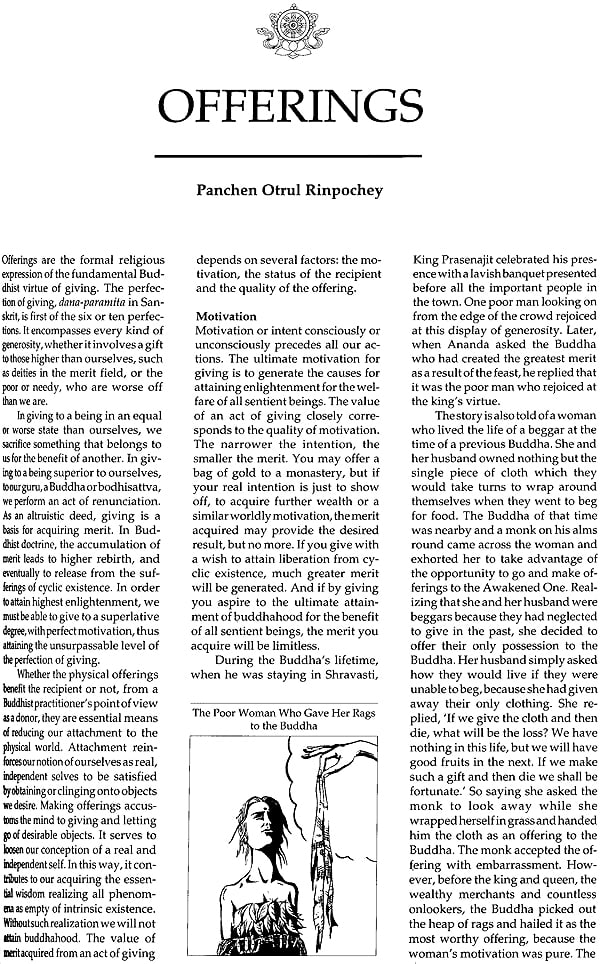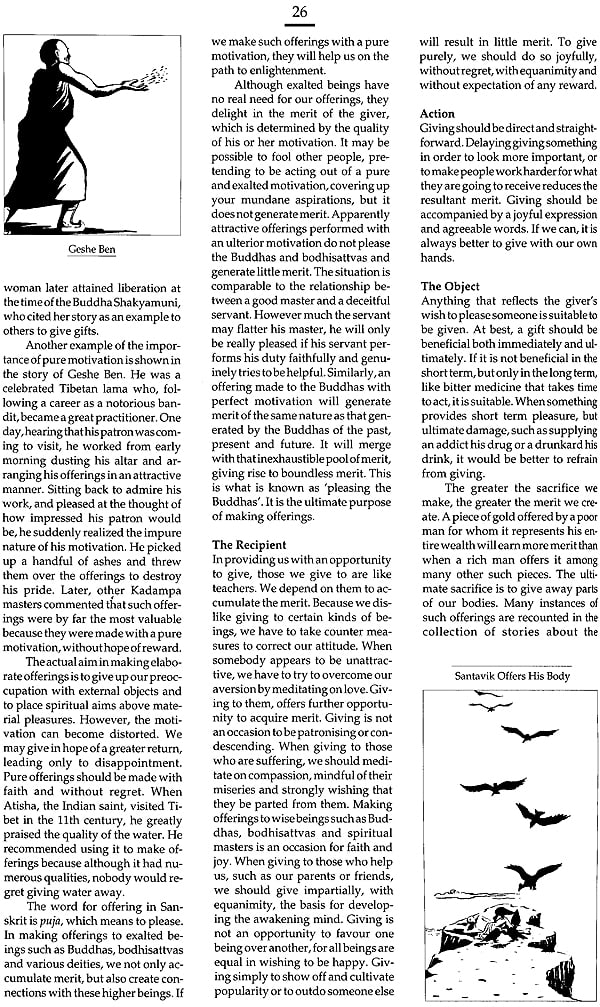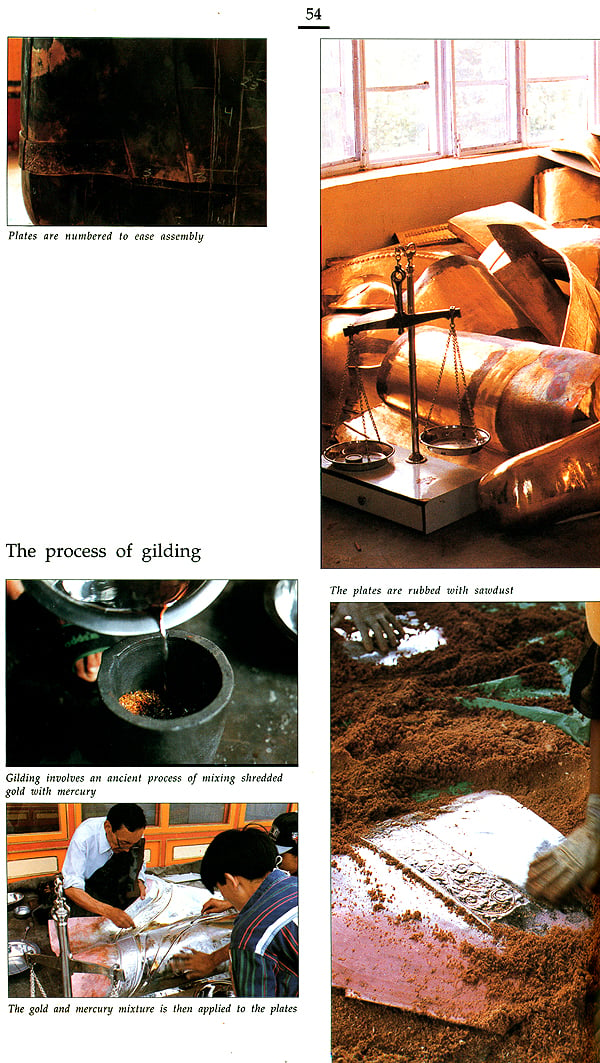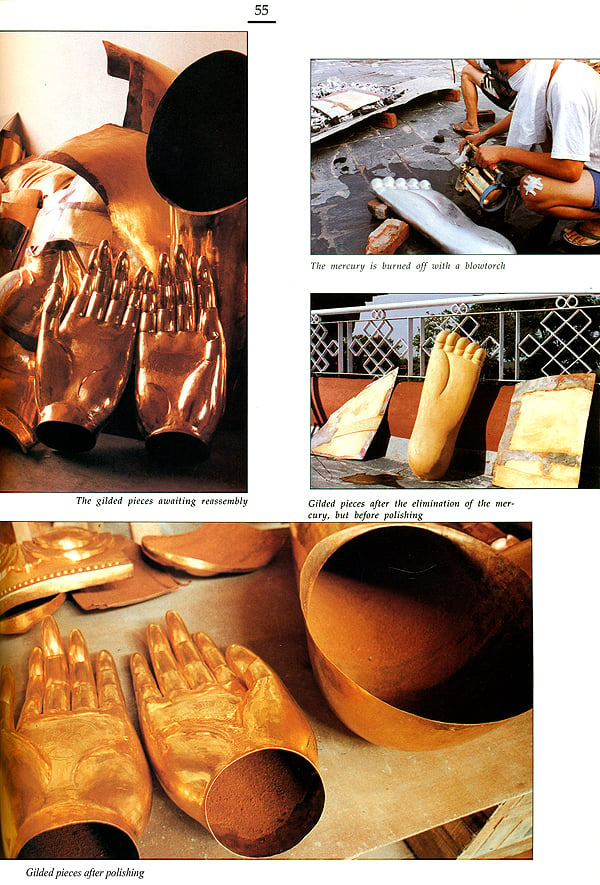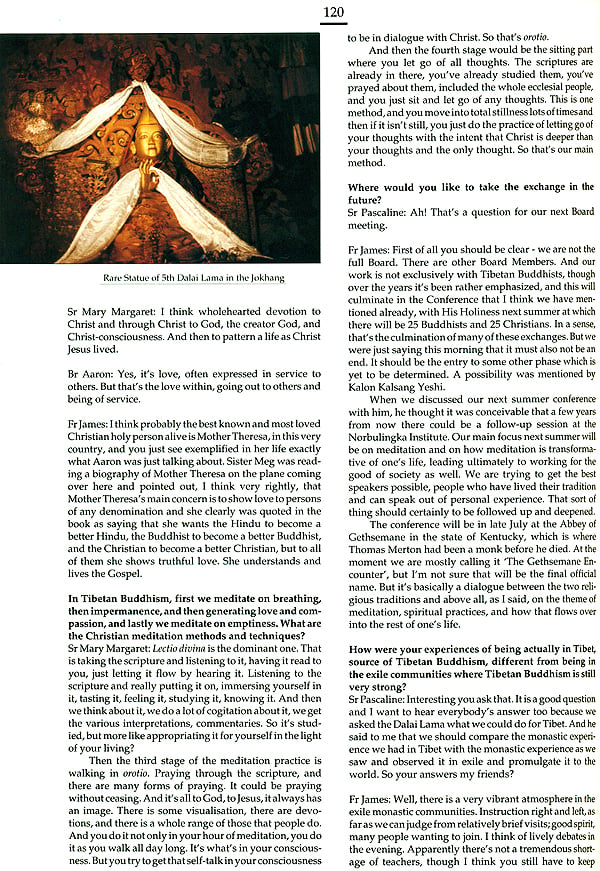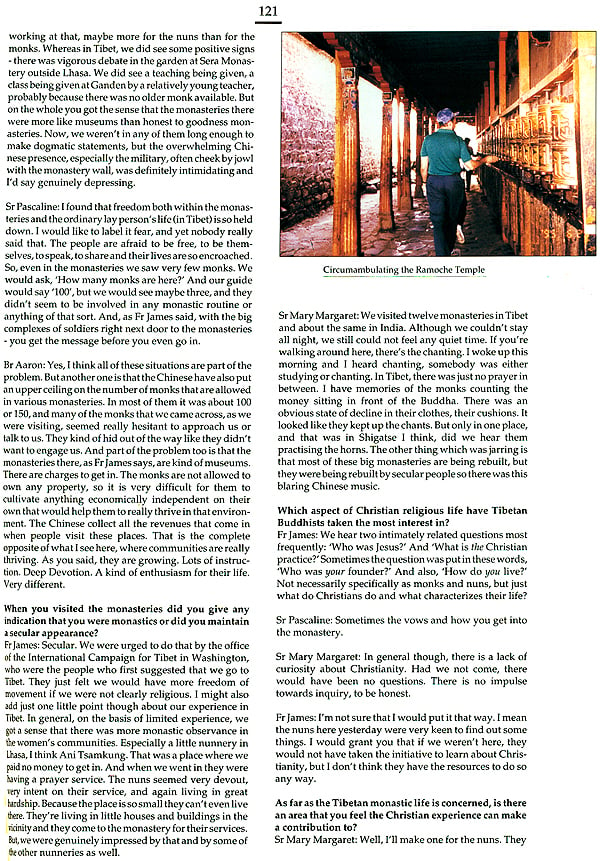
Cho Yang:The Voice of Tibetan Religion and Culture
Book Specification
| Item Code: | NAB778 |
| Author: | Pedron YeshiJeremy Russell |
| Publisher: | Norbulingka Institute |
| Language: | English |
| Edition: | 1996 |
| Pages: | 124 (Illustrated Throughout in B/W & Color) |
| Cover: | Paperback |
| Other Details | 11.8 inch X 8.4 inch |
| Weight | 540 gm |
Book Description
There is a good gathering of people here from different walks of life, including some who have come from Tibet. When we lived in free Tibet, we had every opportunity to do Dharma practice, but unfortunately we have faced some difficulties since then. Today, we are gathered here not to listen to some story or other, but to listen to the Buddhadharma. It is important to transform your body, speech and mind, to attain enlightenment if you can. So, at least during the sessions of these teachings, make an attempt to turn your mind towards spiritual practice. Try to keep in mind whatever meaning you get from these teachings and make yourself familiar with it. Listening to Dharma is not just an academic pursuit. It is meant for taming and transforming the mind. So it is important that, as a result of listening to the Dharma, we should make some transformation in our lives.
Usually before a teaching we recite the verses for taking refuge in the Buddha, Dharma and Sangha and generating the awakening mind, which is the essence of the Buddha's teaching. The first two lines are: I go for refuge until I am enlightened to the Buddha, Dharma and Sangha Taking refuge is to trust and confide in the Buddha, Dharma and Sangha from the depth of your mind. Entrusting yourself to me Buddha, Dharma and Sangha is what distinguishes you as a Buddhist. It is important to have a clear understanding of the nature of the Buddha, Dharma and Sangha. This is achieved through study, thinking and meditation. Ordinary people, with- out such understanding who simply follow the prevailing tradition, saying I rake refuge in the Lama, I take refuge in the Buddha. Dianna and Sangha, without understanding the nature of the Buddha, Dharma and Sangha cannot take refuge m a profound way. They have not gained real conviction through reason or study. There- fore, there can be different levels of taking refuge depending upon your interest, study and your intelligence.
The real way to take refuge in the Buddha, Dharma and Sangha is to emulate their example. You make a determination to become the Buddha and the Dharma yourself, to generate the Dharma within your own mental continuum. When we talk about taking refuge, there are various ways of going about it. Usually, we take refuge in someone who has the capacity to give us shelter or protection. If there are people who have the capacity to remove our sufferings or help us, in a way we take refuge in them. On the other hand if you are capable of fulfilling all your responsibilities yourself, you live somewhat independently and do not have to take refuge in others.
Therefore, there are two levels of taking refuge in the Buddha, Dharma and Sangha. The first is to consider yourself on a lower level without ever thinking of becoming a Buddha. Then second level is to take refuge in the Buddha, Dharma and Sangha with the aspiration that you yourself will become a Buddha and generate the Dharma within your mind. That kind of taking refuge is more profound and more courageous. It all depends on the mental level of the individual.
Then you generate the awakening mind. The last two lines of the traditional verse say: Through the virtuous qualities accumulated by giving, observing ethical discipline and so forth, may l attain Buddhahood for the benefit of all sentient beings} This clearly explains that the purpose of engaging in the practice of the Buddhadharma is not for your personal welfare alone, but to attain enlightenment for the benefit of all sentient beings. That is an extremely wonderful and noble attitude, something we should all aspire to. lf you have such an awakening mind, it is the source of all excellent qualities.
When you recite this verse, taking refuge in the Buddha, Dharma and Sangha and generating the awake ring mind, you should. dedicate whatever virtuous qualities you do to the benefit of all sentient beings. The teacher should explain the teaching with that motivation and the listener should also listen with that motivation. Whatever Dharma practices you do. Whether you do prostrations or circumambulations. You should do them with this motivation. That way, all your virtuous qualities will become a cause for attaining enlightenment for the benefit of all sentient beings. lf you think about the meaning of this one verse when you recite it, your practice will become pro- found. Think about it in such a way that you are really able to generate a strong feeling within your mind.
Usually we recite this verse three times. We do so to make sure that we think about the meaning and, through repeatedly thinking about the meaning of this verse, we make some change in the feeling within our minds. There- fore, sometimes it is useful to recite it not only three times, but even ten. Sometimes you can concentrate only on the first two lines, taking refuge in the Buddha, Dharma and Sangha. Focus your mind on the meaning of those two lines. When you are able to generate a really strong feeling, recite only the lines about generating the awakening mind. Remember that you are doing all these practices in order to attain Enlightenment for the benefit of all sentient beings. That may be more effective in making a change within your mind.
Whatever virtuous practices you do, if right in the beginning you think about the meaning of taking refuge in the Buddha, Dharma and Sangha and generating the awakening mind, all your practices will become very effective. Otherwise, reciting certain prayers might be- come no different from playing a tape recorder. Buddhist practice, like all the different religious traditions, is meant for transforming the mind The way this is done in Buddhist practice is through meditation or mental training. Practices related to the mind are subtler and more difficult than practices related to other senses. So even if you move your lips elegantly when you recite your prayers, if you do not have the correct mental attitude you are not doing real Buddhist practice.
Especially when we have the opportunity to do Buddhist practice, it is important to understand the main thrust of the Buddha’s teaching. The Buddhadharma is to be done through the mind. If we are simply content with practices like circumambulation and so forth, forgetting the mental practice, then it is doubtful whether our practice is really Buddhist. Sometimes when we have ample time on our hands, it can be very comfortable to do circumambulations or prostrations. But if you go with a talkative friend, exchanging gossip and so forth, it is not a religious practice. It is possible to do circumambulation while thinking of deceiving such and such a person, or making money, but you are just wasting your time, because you are thinking about doing various negativities. People who observe you might feel, and you yourself might feel, that you are doing religious practice, but actually you are not, because your mind is turned in another direction.
Now, what does doing Dharma practice through the mind mean? For example, if you are angry and seeing the faults of anger and the benefits of a calm mind, you reduce your anger. Then, if, by focusing on what or whomever made you angry, you generate a more loving attitude by thinking about the benefits of love and kindness you will be able to transform your earlier attitude. If you think that this person is similar to you in wanting happiness and not wanting suffering, you will be able to generate a real feeling of compassion towards him or her. That is real Dharma practice. That is how your mind can be trans- formed. Your earlier harmful intention is now trans- formed into a loving attitude. It is extremely difficult, but it is wonderful. That is real Dharma practice. This is also why we say that Buddhist practice is done by the mind.
If we voluntarily profess to be Buddhists and profess to be followers of the Buddha, it is our responsibility to follow the Buddha’s instructions. It is our duty and re- sponsibility to reduce and eliminate anger, attachment and hatred. We are followers of the Buddha, in our homes we have images of the Buddha. We also go on pilgrimage and generate great respect for images of Buddha Shakyamuni. But if we accept Buddha Shakyamuni as our teacher and if we like his teaching, then it is important to follow it. At least we can do those things which please the Buddha and not those things which displease him. If we do not engage in such a practice then we are simply deceiving ourselves and deceiving Buddha Shakyamuni when we say that we take refuge in the Buddha, Dharma and Sangha.
Now, when I climb on the throne to give you the teaching, it would be unworthy of me to be proud that I am the Dalai Lama and so forth. I am a bhikkshu, a follower of Buddha Shakyamuni, who cherishes the instruction and teaching of Buddha Shakyamuni, and sincerely tries to practice what Buddha Shakyamuni teaches. I practice his teaching not simply to please him, not simply to flatter him; I am not following his practice because all my happiness is in the hands of the Buddha. I am following the teaching of the Buddha because it is beneficial for me in the long-run. We all want happiness and do not want suffering. And this wish will not last just for the next few days or few years, but for many lives to come. Whether we have happiness or not is in our own hands. In order to find happiness in the long run and not to encounter suffering, we have to work hard. The root of suffering is ignorance, anger and attachment. Seeing these negativities as the enemy, and cherishing the qualities of the awakening mind, the wisdom understanding emptiness, and so forth, is all for our own benefit. Therefore, as a follower of Buddha Shakyamuni, I am practising what he taught. Although he taught the Four Noble Truths and the Two Truths 2,500 years ago, each time I think about them they become more true, my conviction about them increases.
I always think of myself as an ordinary bhikkshu, an ordinary follower of the Buddha. Other people are the same as me. Therefore, it may be useful to discuss what I know with you and with that kind of motivation, a motivation to benefit, I give these teachings. Even if we are able to benefit just one person, it fulfils the teaching of the Buddha. The Buddha himself first generated the awakening mind, then he accumulated extensive merit, and finally he attained Enlightenment. He did all this for the benefit of sentient beings. He followed his practice for countless aeons without getting discouraged, and finally attained enlightenment. This was possible because he had the most wonderful cause: the awakening mind. Therefore, if through our own teaching, or through our own good behaviour, we are able to make even one person lead a positive way of life or cause happiness to arise within the mind of that person, it is a great service to the Buddhadharma, but it also fulfils our own benefit.
Whatever Dharma practices we do, should be done with the right motivation. Generally speaking, to habituate ourselves with positive qualities is extremely difficult, while acquaintance with negative activities comes automatically. Therefore, the ancient Kadampa masters used to say that accumulating negative activities is like a stone rolling down a steep slope, but engaging into positive practice is like driving water upstream or leading an exhausted horse. Whether we are awake or asleep, disturbing emotions automatically arise. This is then manifest in our daily behaviour. We engage in negative activities even knowing they are wrong.
Since we have found this precious human birth, and we have come together to listen to the teaching, it is important that we should generate a positive motivation. Only then will listening to the teaching become a spiritual practice. When we talk about accumulating positive deeds and eliminating negative deeds, we do so not because the Buddha has told us to, but because the Buddha’s teaching is based on the natural law of cause and effect. When he taught the Four Noble Truths, he also explained the way cause and effect works. Happiness arises in dependence on causes and conditions and suffering too, arises in dependence on causes and conditions; this is a law of nature. The happiness we experience in this very life, whether it is material prosperity, better education or whatever, comes about as a result of accumulating the necessary causes and conditions.
These different causes and conditions arise in direct relation to human behaviour, which is related to our human way of thinking. And these different concepts or ways of thinking within the human being do not arise without cause or condition. Human beings have a physical body and to some extent different conceptual thoughts arise because of the condition of the physical body. For example, if you are physically well and healthy, you feel mentally relaxed and happy. For consciousness to arise there has to be an external object as the focus of that mind, and when it also reacts with the physical circumstances that mind arises. Whether you call it the brain, or what- ever physical reality you attribute to the mind, it is not only the physical substance that gives rise to the mind.
The mind is something which has clarity and the capacity to know. The formation of the physical human body starts with the union of the father and mother’s sperm and eggs. As it develops, consciousness also takes part. But the actual substance of the mind is not the physical body but a previous mind. The feelings of hap- piness and suffering that we encounter should be traced not only to the physical body, but also to the subtlest mind. Therefore, in tantric teachings we find explanation of the subtlest mind called primordial clear light mind. When we talk about the continuity of life, it is explained in terms of the continuity of the clear light mind.
We have different experiences because of our behaviour and our different behaviour arises because of different mental attitudes. Basically we are all the same in wanting happiness and not wanting suffering. Lf you were to ask even people who seem to be cruel and bent on fighting or waging war whether they really want to fight, the answer will be negative. They also are similar to us in wanting happiness and not wanting suffering. We en- gage in foul activities because we are overpowered by ignorance. Ignorance is so strong that despite our wanting something else, we are compelled to engage in destructive activities. We see destructive activities through- out the world, which shows the great potency of the human mind to control everything.
Our feelings of happiness and suffering are very much dependent on our behaviour, which is very much related to our way of thinking. Those mental attitudes which are negative and unworthy should be reduced and eliminated. We should identify constructive kinds of mind and promote and develop them this method of transforming the mind is what we call Dharma or spiritual practice. That is why the Buddha’s teaching says that we should not do evil acts. We should do positive acts. Because we want happiness and don’t want suffering. And happiness comes from doing positive acts. While suffering comes from doing negative acts.
Since the mind is like a spring, the source of our stream of experience, it is important to control this source of experience - in other words, transform the mind. Politicians try to control peoples' minds with programmes like class struggle and so forth, but as these are mainly based not on transforming the mind but on how to gain victory for your own party and defeat the other party, therefore they are always unsuccessful. The method for transforming the mind is to see that whatever we do, if the result will be negative, we should not do it. lf we can see that by doing something it will lead to happiness and peace, then we can happily do it.
When the Buddha taught the F our Noble Truths and introduced true suffering, he did so not to depress us or make us feel sad. lf there were no means to remove suffering then there would be no need to talk about it. But the Buddha did not speak only about true suffering, he also spoke about the causes of suffering and the possibility of removing that suffering, the path leading to the cessation of that suffering. Negativities and disturbing emotions are temporary but have a certain force. If we familiarise our minds with the antidotes to these negative minds, we can definitely defeat them. True cessation or nirvana refers to our mind being completely free from disturbing emotions and sufferings. If it is possible to attain such a state, it is worthwhile for us to find the proper method to do so and to work to achieve it.
| Discourse | The Abridged Stages of the Path to Enlightenment – His Holiness the Dalai Lama | 3 |
| Pleasing Tune of the Nectar of Immortality – Jamyang Khyentse Chokyi Lodoe | 23 | |
| Offerings- Panchen Otrul Rinpochey | 25 | |
| The Qualities to Look for in Selecting a Spiritual Guide – Khenpo Chordrak Rinpochey | 93 | |
| Personalities | Interview with Jetsun Kushab | 95 |
| The 100TH Holder of the Ganden Throne | 59 | |
| Arts & Artists | An Original Tibetan Painter- Dugu Choegyal Rinpochey – Diane Barker | 63 |
| Gonkar Gyatso – Creation of a Painter in Contemporary Tibet – as told to Kim Yeshi | 73 | |
| Dr Dawa – Pioneer of Tibetan Botanical Painting | 86 | |
| Religion & Culture | Construction of a Gilded Metal Statue of Buddha Shakyamuni- photos | 53 |
| Torma – The Tibetan Ritual Cake – Claudia Butler | 38 | |
| Treasures of the Drukpa Kargyu in Khan – Jeremy Russell | 106 | |
| Culture | The Wedding Hostesses of Central Tibet – Keila Diehl | 102 |
| Dialogue | Monastic Interrelagions Dialogue | 127 |
